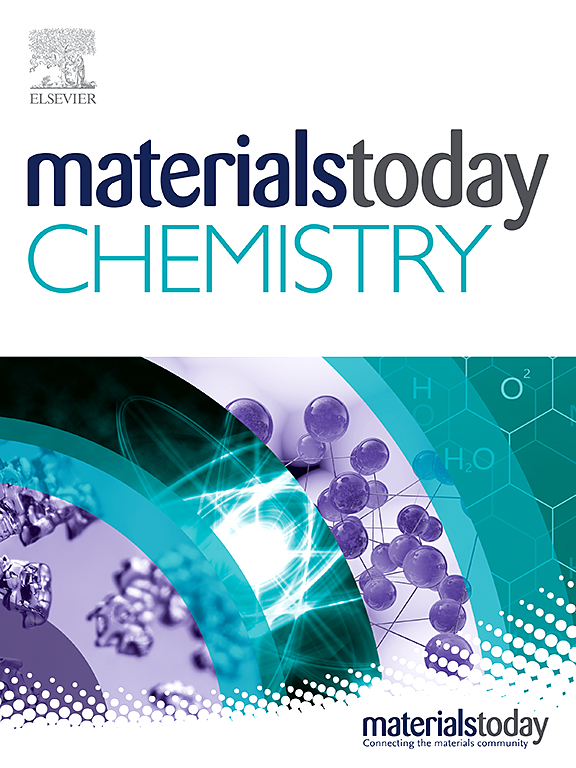Sensing diversity in halogen-bonded multi-stimuli responsive materials: Light, pH, magnetism, and electron-rich species
IF 6.7
2区 化学
Q1 CHEMISTRY, MULTIDISCIPLINARY
引用次数: 0
Abstract
The present study delves into the synthesis and characterization of multi-stimuli responsive polymers, demonstrating their sensitivity towards magnetic field, pH level, light irradiation, and electron-rich species through halogen bonding (XB). Detailed X-ray analyses of two azobenzene derivatives, each incorporating a tetrafluoroiodobenzene group, provided the compelling evidence of engagement of the building blocks in the formation of halogen bonds. Interestingly, the investigation of an ammonium analog, featuring a tetrahalogenoferrate(III) anion, not only showcased a magnetic response even upheld its ability to undergo isomerization under UV irradiation. These functional properties were subsequently harnessed in the form of multi-responsive compounds through the random quaternization of poly(2-(N,-dimethylamino) ethyl methacrylate) (PDMAEMA), and by employing varying proportions of XB-donor dye (8, 11, 15, 21, and 43 %) followed by magnetic anion exchange. Leveraging the presence of free ternary amino groups and diazobenzene moieties, the resulting polymers demonstrated pronounced sensitivity towards a variation of pH and UV light stimuli, while a careful modulation of magnetic susceptibility was found to be directly proportional to the degree of quaternization. An NMR titration, conducted using a synthetic intermediate, revealed the formation of I⋯Cl‾ interactions in the solution state, thereby underscoring the materials' sensitivity to electron-rich species. Moreover, the electron microscopic analysis displayed an alteration in morphology upon the application of a magnetic field and UV irradiation. Thus, the presented strategic framework offers an avenue for the development of multi-stimuli responsive materials for remotely controlled smart devices to act in response to a diverse set of four stimuli, and heralding a significant advancement in the realm of responsive material design.卤素键合多刺激响应材料的传感多样性:光、pH 值、磁性和富电子物种
本研究深入探讨了多刺激响应聚合物的合成和表征,通过卤素键(XB)证明了它们对磁场、pH 值、光照射和富电子物种的敏感性。对两种偶氮苯衍生物(每种衍生物都含有一个四氟碘苯基团)进行的详细 X 射线分析提供了令人信服的证据,证明构件参与了卤素键的形成。有趣的是,对一种以四卤代铁酸锂(III)阴离子为特征的铵类似物的研究不仅显示了磁性反应,甚至还证明了它在紫外线照射下发生异构化的能力。随后,通过对聚(2-(N,-二甲基氨基) 甲基丙烯酸乙酯)(PDMAEMA)进行随机季铵化,并采用不同比例的 XB 供体染料(8%、11%、15%、21% 和 43%),然后进行磁性阴离子交换,这些功能特性以多响应化合物的形式得到了利用。利用游离三元氨基基团和重氮苯分子的存在,所得到的聚合物对不同的 pH 值和紫外线刺激具有明显的敏感性,同时发现磁感应强度的细微调节与季铵化程度成正比。使用合成中间体进行的核磁共振滴定显示,在溶液状态下形成了 I⋯Cl‾ 相互作用,从而强调了材料对富电子物种的敏感性。此外,电子显微镜分析表明,在应用磁场和紫外线照射时,材料的形态会发生改变。因此,所提出的战略框架为开发用于遥控智能设备的多刺激响应材料提供了一条途径,使其能够对四种不同的刺激做出响应,并预示着响应材料设计领域的重大进展。
本文章由计算机程序翻译,如有差异,请以英文原文为准。
求助全文
约1分钟内获得全文
求助全文
来源期刊

Materials Today Chemistry
Multiple-
CiteScore
8.90
自引率
6.80%
发文量
596
审稿时长
33 days
期刊介绍:
Materials Today Chemistry is a multi-disciplinary journal dedicated to all facets of materials chemistry.
This field represents one of the fastest-growing areas of science, involving the application of chemistry-based techniques to the study of materials. It encompasses materials synthesis and behavior, as well as the intricate relationships between material structure and properties at the atomic and molecular scale. Materials Today Chemistry serves as a high-impact platform for discussing research that propels the field forward through groundbreaking discoveries and innovative techniques.
 求助内容:
求助内容: 应助结果提醒方式:
应助结果提醒方式:


